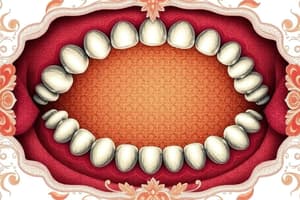Podcast
Questions and Answers
What does periodontal probing provide information about?
What does periodontal probing provide information about?
Possible etiology and prognosis.
Which of the following thermal tests can be performed for pulp testing? (Select all that apply)
Which of the following thermal tests can be performed for pulp testing? (Select all that apply)
- Cold test using air blasts (correct)
- Hot test using heated gutta-percha (correct)
- Electrical pulp test with EPT (correct)
- None of the above
What does EPT stand for in dental testing?
What does EPT stand for in dental testing?
Electrical pulp test.
A response to thermal tests that indicates necrotic pulp is _____ to thermal tests.
A response to thermal tests that indicates necrotic pulp is _____ to thermal tests.
What is typically indicated by a response of severe, momentary pain lasting 1–2 seconds after the removal of the stimulus?
What is typically indicated by a response of severe, momentary pain lasting 1–2 seconds after the removal of the stimulus?
Match the pulpal diagnoses with their response to thermal testing:
Match the pulpal diagnoses with their response to thermal testing:
Which sign indicates acute apical periodontitis?
Which sign indicates acute apical periodontitis?
What might a crack in a tooth indicate?
What might a crack in a tooth indicate?
What is the most common cause of a split tooth?
What is the most common cause of a split tooth?
Endodontically treated teeth are not susceptible to vertical root fractures.
Endodontically treated teeth are not susceptible to vertical root fractures.
What characterizes a vertical root fracture?
What characterizes a vertical root fracture?
Which diagnostic test can visually verify cracks in teeth?
Which diagnostic test can visually verify cracks in teeth?
What symptoms may a patient report in case of a vertical root fracture?
What symptoms may a patient report in case of a vertical root fracture?
What appearance may be observed on radiographs for a vertical root fracture?
What appearance may be observed on radiographs for a vertical root fracture?
A sinus tract often traces to the apex of the root.
A sinus tract often traces to the apex of the root.
Flashcards are hidden until you start studying
Study Notes
Periodontal Probing
- Provides insights into potential dental etiologies and prognoses.
- Narrow pockets may indicate root fractures or pathologies of pulpal origin.
Pulp Tests
-
Thermal Tests:
- Cold Test: Can be conducted using air blasts, ice sticks, ethyl chloride, "Endo Ice" (difluorodichloromethane), or CO2 sticks.
- Hot Test: Carried out with heated gutta-percha or hot water.
-
Electrical Pulp Test (EPT):
- Requires teeth to be dry before testing.
- A conductive medium such as toothpaste is applied to the tester's tip.
- The patient holds the handle of the tester, releasing it when feeling the current.
- EPT indicates whether a tooth is vital (reading 1–79) or necrotic (reading 80), but does not confirm pulp diagnosis.
- High rates of false-positive and false-negative results necessitate additional tests.
Pulpal Diagnosis
- Primarily achieved through thermal tests, assessing the vitality of pulp.
- Responses to thermal testing indicate:
- Normal Pulp: Mild to moderate pain lasting 1-2 seconds post-stimulus.
- Reversible Pulpitis: Severe, momentary pain lasting 1-2 seconds after stimulus removal.
- Irreversible Pulpitis: Moderate to severe pain that lingers.
- Necrotic Pulp: No response to thermal tests.
Periapical Diagnosis
- Should be assessed alongside pulpal diagnosis for teeth requiring endodontic intervention.
- Signs and symptoms for diagnostic categories include:
- Normal Periodontium: No radiolucency and normal responses to percussion and palpation.
- Acute Apical Periodontitis: Painful response to biting and percussion.
- Chronic Apical Periodontitis: Periradicular radiolucency present without symptoms.
- Acute Exacerbation of Chronic Apical Periodontitis: Painful response to biting and percussion with radiolucency.
- Acute Apical Abscess: Rapid onset of spontaneous pain, tenderness to percussion, and pus formation.
Tooth Cracks
- Cracks commonly observed in minimally restored posterior teeth, especially mandibular molars.
- Cracks extend primarily from mesial to distal direction and may indicate issues such as pulp canal obliteration, immature teeth, or previous trauma.
Split Tooth
- A split tooth is completely divided into two segments.
- It typically arises from the progressive deterioration of a previously cracked tooth.
Vertical Root Fracture
- Defined as a crack starting in the root, extending toward the occlusal surface in a buccal-lingual direction.
- Commonly occurs in teeth that have undergone endodontic treatment.
- Symptoms include a history of abscess or sinus tract formation, plus pain when biting or palpating the area.
Diagnostic Tests for Vertical Root Fracture
- Visual inspection can reveal visible cracks.
- Periodontal probing may indicate a narrow periodontal pocket.
- Radiographs display:
- A diffuse radiolucency along the root's length, possibly shaped like an ellipse or a J.
- Fracture lines may be identified by taking radiographs from various angles.
- Sinus tracts may not necessarily point to the root's apex.
Studying That Suits You
Use AI to generate personalized quizzes and flashcards to suit your learning preferences.



